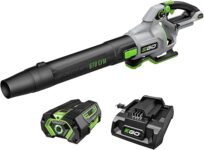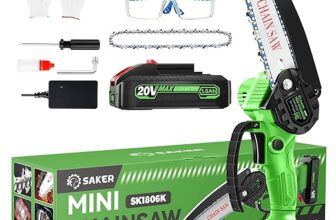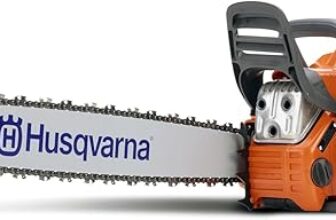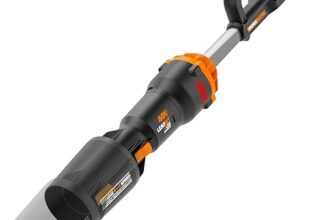
Top 5 Cordless Leaf Blowers for Homeowners
Can a battery hush the roar and still clear the yard? Here are the top 5 cordless leaf blowers — plus a few extra models worth comparing.
Leaves don’t stand a chance. Heaps on the lawn, crunchy sidewalks, and a neighbor who mows at 7 a.m. — cordless blowers make the job fast and mostly quiet. They cut the sweat and the trips to the gas can.
Top Cordless Leaf Blower Picks








56V 670 CFM Blower Kit with Battery
High airflow and a large ARC Lithium battery deliver long, useful run times for medium and large yards. The turbo mode and cruise‑control make it easy to tackle wet leaves and stubborn debris with fewer battery swaps.
What it is and who it's for
This kit combines a high‑flow blower with a 56V ARC Lithium battery and charger, aimed at homeowners with mid‑sized to large yards who need long runtime and gas‑level clearing power without fumes. Its turbine‑style fan and brushless motor are tuned for moving wet leaves and dense debris.
Key features and benefits
The practical payoff is fewer battery swaps on larger chores and operator comfort during long runs: cruise control reduces hand fatigue and the speed dial lets users choose efficiency or sheer force depending on the task.
Practical notes, limitations and tips
Weight (about 11.7 lb with battery) is a tradeoff for runtime and airflow — someone who prioritizes portability over sustained power should consider lighter options. The turbo mode is a useful short‑burst function but drains charge quickly; plan battery management accordingly. Buyers outside the U.S. should verify charger voltage and region compatibility before purchase.
Real‑world usage insight
Users praise the consistent torque and long battery life for clearing large driveways and rock beds. One homeowner reported swapping the charger quickly through customer service when needed and valued the interchangeable battery ecosystem for other yard tools.
40V Whisper HP 730 CFM Jet Blower
Delivers exceptionally high CFM while staying surprisingly quiet, which makes it ideal for early morning or late‑evening cleanup. The jet‑fan design and turbo button give it punch for big piles, while cruise control eases operator fatigue.
What it is and who it's for
This RYOBI 40V Whisper HP blower is targeted at homeowners who want the highest handheld airflow without the typical roar of gas engines. It’s a jet‑fan design that emphasizes CFM and low acoustic output, suited for clearing large yards, driveways, and stubborn wet leaves while keeping noise down.
Key features and benefits
The result is a blower that handles heavy loads normally reserved for larger cordless or gas models, but with a lower noise impact on neighbors and bystanders. Cruise control is handy for extended passes and reduces hand fatigue during long jobs.
Practical notes, limitations and tips
Expect significant battery draw when using turbo or high sustained speeds — two or more high‑capacity batteries are recommended for large properties. The unit’s weight increases with battery presence and may become tiring for smaller users on prolonged tasks. Buyers should also be alert to vendor return and warranty processes if they encounter a defective unit.
Real‑world usage insight
Reviewers who swapped from gas handhelds report similar clearing performance with the advantage of quieter operation and no fuel hassles. For homeowners wanting near‑commercial handheld power with residential sound levels, this model is a rare, compelling combination.
80V 700 CFM Commercial‑Grade Blower Kit
Delivers gas‑level airflow and a rapid charger to minimize downtime, making it a top pick for big yards and heavy debris. It’s a good bridge for users who want backpack‑style performance from a handheld, cordless unit.
What it is and who it's for
This 80V Greenworks blower is geared toward homeowners who want performance close to a 27cc gas engine without dealing with fuel, oil, or engine maintenance. It’s designed for wet leaves, compacted debris, gravel, and heavier clearing tasks that demand both airflow and momentum.
Key features and benefits
The combination of high airflow and a quick charger means users can complete more work with fewer interruptions; this is especially helpful on larger properties where running time is the limiting factor.
Practical notes, limitations and tips
While powerful, battery life at maximum settings is limited — many owners run on high only when needed and rely on medium settings for general clearing. The unit is heavier than compact blowers, so people sensitive to wrist or shoulder strain should test balance with the battery installed. As with any high‑power cordless tool, warranty and service responsiveness matter; there are a handful of reports of early failures but reliable warranty replacements when service channels were engaged.
Real‑world usage insight
Owners repeatedly highlight the ability to move waterlogged leaves and large piles that smaller tools struggle with. For households that formerly used gas handhelds or for contractors doing light commercial work, the 80V unit is a practical, quieter, and lower‑maintenance alternative.
36V (18V x2) Brushless Handheld Blower
A heavyweight in performance with a build quality that leans toward prosumer users. It delivers quiet, efficient airflow and nuanced control for homeowners who want near‑commercial power without gas maintenance.
What it is and who it's for
This is a dual‑battery 36V (18V x2) cordless blower aimed at homeowners who want near‑professional performance with cordless convenience. It uses Makita's BL brushless motor and the LXT battery platform, which gives it a long service life and predictable runtime when paired with higher‑capacity 18V packs.
Key features and benefits
These features translate into usable benefits: it moves wet leaves and dense debris better than most single‑battery 20V tools, runs quietly for its class, and offers a speed dial plus trigger that lets users dial in power for delicate tasks or full bore cleaning.
Practical notes, limitations and tips
This blower is heavier than compact models (8.4 lb bare) and requires two LXT batteries to operate, which makes the initial investment larger. Users who already own Makita 18V batteries will find it an elegant upgrade; newcomers should plan to buy at least two batteries to realize its runtime potential. For longer jobs, a spare pair of batteries or a battery swap strategy is recommended.
Real‑world usage insight
In practice, it excels for driveway, patio, and roof cleanup where a single‑battery blower struggles. One user noted easy control with the dial and trigger lock options for sustained use, while another found the forearm weight manageable by switching hands. If someone wants a cordless unit that genuinely replaces many gas handhelds for typical homeowner work, this is a top pick.
20V MAX XR Lightweight Handheld Blower
Compact balance and competent airflow make it the easiest option for everyday cleanup. It pairs well with a 20V battery ecosystem and is a sensible choice if portability and simplicity matter more than extreme CFM numbers.
What it is and who it's for
This compact 20V MAX XR blower targets homeowners who want a no‑fuss, lightweight cordless solution for daily tidying: blowing grass clippings, cleaning patios, and spot cleanup around vehicles. It fits neatly into a 20V battery ecosystem for people who already own compatible tools.
Key features and benefits
The blower's design emphasizes maneuverability. For quick jobs and frequent short sessions, the combination of light weight and a variable trigger with speed lock is a practical advantage: users can dial in a steady output without gripping the trigger the entire time.
Practical notes, limitations and tips
Because this is a tool‑only listing, buyers who don't already own 20V batteries should factor in the cost of a battery and charger. Run time will depend on battery capacity; a 4Ah or larger pack is recommended if users want a meaningful continuous runtime for several small jobs. For larger properties or heavy, waterlogged leaves, a higher‑voltage machine will be more effective.
Real‑world usage insight
Owners report that it's quiet, powerful for its size, and a welcome replacement for corded units. They appreciate the balance and control for close‑quarters work, but many recommend keeping a spare battery for longer sessions.
40V Brushless 550 CFM Blower Kit
A capable brushless 40V blower that ships with battery and charger, offering reliable clearing power for most yards at a competitive price. It’s a good fit for homeowners invested in a 40V battery platform who want simple controls and a lightweight feel.
What it is and who it's for
This 40V Greenworks blower is positioned as a practical, mid‑power cordless option for homeowners who want more airflow than entry‑level 20V units without stepping up to the 80V and 56V classes. It typically ships as a kit with a battery and charger, making it a useful first purchase for people committed to the Greenworks 40V ecosystem.
Key features and benefits
In practice, the blower handles yard debris, mulch edges, and built‑up detritus around garden beds without excessive arm strain. The included battery and charger mean users can start work immediately, and the compatible battery system can be shared with other tools.
Practical notes, limitations and tips
Noise levels and build variations across production runs are worth noting — some users find it noisier than competing designs. There are isolated warranty and replacement complaints; buyers should register their product and keep proof of purchase. For heavy wet leaves or long, continuous clearing, the 40V class is serviceable but may need spare batteries or occasional breaks to recharge.
Real‑world usage insight
Users generally praise its convenience and balance, especially if they already own 40V Greenworks batteries. For homeowners with modest to medium cleanup needs, it delivers good value without the weight and complexity of higher‑voltage systems.
20V Lightweight Blower with Attachments
Ultra‑lightweight and supplied with multiple attachments, it’s the best choice for decking, garage, car interiors, and other detail tasks. It’s convenient to keep around the house for quick jobs where large blowers are overkill.
What it is and who it's for
This WORX 20V blower is a detail‑oriented tool rather than a yard‑clearing machine. It’s designed for users who want a single, lightweight tool they can use for multiple small tasks: blowing pine needles, clearing garage corners, detailing a car, or inflating/deflating pool toys.
Key features and benefits
For owners who value utility and convenience, this is a practical tool to keep on hand. The range of attachments expands use cases beyond just leaves, and the light weight makes it accessible to older users and those who dislike heavier handhelds.
Practical notes, limitations and tips
It isn’t engineered for heavy blowing tasks — larger patios and soaked leaves will require a higher‑CFM machine. Battery life depends heavily on the pack used; for frequent outdoor use, choose a higher‑capacity PowerShare battery. The attachments are helpful but don’t compensate for the blower’s modest raw airflow.
Real‑world usage insight
Owners often keep it by a back door for fast cleanups and for car interior jobs where a big blower is awkward. If a homeowner needs a single tool for light outdoor jobs plus household detail work, this model is a flexible and comfortable choice.
18V ONE+ Compact 250 CFM Blower
A compact, no‑frills blower that works well for sidewalks, patios, and quick touchups. It’s a good option for owners already invested in the 18V ONE+ battery ecosystem or those who want a cheap, lightweight spot‑cleaning tool.
What it is and who it's for
This entry‑level RYOBI ONE+ blower is designed for homeowners who need a low‑cost, lightweight blower for quick cleanups around hard surfaces, steps, and walkways. It’s an attractive add‑on for people who already own RYOBI 18V batteries and chargers.
Key features and benefits
The main benefit is convenience: the tool is small enough to keep near a garage door and handy for short jobs that otherwise would require a broom. For occasional use and small yards, it’s efficient and inexpensive.
Practical notes, limitations and tips
It’s not intended for heavy leaf loads, wet leaves, or rock beds. Users should plan on short runtimes and consider a spare battery if they expect to do longer tasks. For those who need more raw power, stepping up to a 40V/56V/80V blower is the recommended path.
Real‑world usage insight
Owners find it valuable for quick touchups and elderly users praise the light weight. As a budget choice, its performance is proportional to price — useful for small‑scale jobs but no substitute for higher‑CFM machines.
Final Thoughts
For most homeowners who need long, worry-free run time and true clearing power, the 56V 670 CFM Blower Kit with Battery is the top pick. It pairs high airflow with a large ARC Lithium battery, so they can tackle medium to large yards and wet leaves without constant battery swaps. The turbo mode and cruise control make long sessions easier and more efficient.
If quiet operation matters as much as raw punch, the 40V Whisper HP 730 CFM Jet Blower is the best alternative. It delivers near‑top CFM while staying noticeably quieter, making it ideal for early‑morning or late‑evening cleanups and for neighborhoods with noise rules. Its jet‑fan design and turbo boost give real bite for big piles, while cruise control reduces operator fatigue.








I was surprised the Ryobi 40V made the list as the “Whisper HP” — I expected it to be louder. Here’s my two cents after using the Ryobi for a full season:
1) It’s impressively quiet compared to other high-CFM blowers I had nearby.
2) The jet-fan design really moves large piles but the unit is kinda bulky.
3) Cruise control is legit for reducing arm fatigue.
One caveat: listed as tool-only — so factor in battery cost. Also, any tips on storing it over winter? I live in an area where temps dip well below freezing, and I’m worried about leaving it in the garage.
I keep mine in the house during winter and it’s been fine. Don’t let liquids freeze near the motor area. Also, if you live somewhere snowy the Ryobi’s power is nice for driveway snow removal (light drifts).
Good note on the tool-only aspect — we called that out because many readers assume battery inclusion. For winter storage: remove the battery, store it indoors at room temp around 40–70°F, and keep it about 30–50% charged. Clean the blower of debris before storing and keep it in a dry spot.
One more tip: if you have access to the Ryobi ONE+ 40V battery ecosystem, battery sharing can offset the ‘tool-only’ cost. But make sure charger compatibility and capacity match your needs.
Agree on noise — surprise factor for me too. It’s quieter than old gas blowers and even some corded ones. Bulky but worth it if you want quieter high CFM.
Been a gardener for years — my preference is for backpack-style for long runs, but for a homeowner summary this list is solid.
Greenworks 80V gives me near-gas performance when I need to clear heavy debris. Makita handles medium jobs with less noise. For driveways with gravel, the high CFM is necessary; otherwise you’re just moving rocks around.
If you want my practical tip: use a medium setting to collect leaves into piles and then use short bursts on high to push them to the curb. Saves battery and your arms.
Good technique. Also consider a rake for stubborn clumps then finish with the blower — less battery drain overall.
Great tactical tip — medium setting for sustained clearing and bursts on high for stubborn spots. We’ll add that to the care guide.
Exactly. Tools are for finishing, not always for full extraction of wet, matted leaves.
I’m torn between the DEWALT and the EGO. I live on a half-acre with mostly dry leaves, but some stubborn wet patches after rain.
DEWALT is appealing because it’s light and pairs with my existing 20V kit. EGO promises higher CFM and long runtime.
Is the DEWALT going to struggle on damp piles or should I just get a bigger rake and save money? Also, how important is CFM vs MPH in real terms?
If budget allows, think of it this way: DEWALT = convenience and portability; EGO = capability and fewer compromises on wet debris.
CFM (volume) moves more leaves across a wider area; MPH (speed) gives more force at the nozzle. For damp piles, CFM plus consistent sustained power helps; that favors EGO. DEWALT is great for light/dry leaves and quick touchups. If you already have 20V batteries and your wet patches are rare, try DEWALT first and supplement with a rake for wet piles.
CFM matters more for shove/transport, MPH for dislodging stuck debris. For half-acre with occasional damp piles, EGO is the safer bet, but DEWALT plus good technique can work too.
Funny how we argue about CFM like it’s religion. 😂
I bought the Ryobi ONE+ P21011 as a budget stopgap and it does fine for patio and sidewalk cleanup. It’s tiny and kinda cute. My neighbor’s gas leaf blower still scares the cat though.
Haha — CFM wars are real. For spot-cleaning, the RYOBI ONE+ is a sensible, inexpensive choice. Keeps the peace with neighbors compared to gas units.
Cats definitely prefer the cordless ones. My neighbor’s leaf blower once sent my cat under the bed for an hour 😅
I went with the Greenworks 40V because it came with a 4.0Ah battery and charger — such a good value for a household that doesn’t want to buy batteries separately. Works great for my small yard and the handle is comfy.
Anyone tried both Greenworks 40V and the DEWALT 20V? Curious about the noticeable differences in real-world clearing power.
Also consider battery ecosystem: 40V Greenworks offers a lot of compatible tools if you plan to expand.
Greenworks 40V will have more sustained power and airflow than the 20V DEWALT, especially for heavier leaves and slightly bigger runs. DEWALT is lighter and more maneuverable for quick jobs. If you already own 20V tools, DEWALT is convenient; if you want more oomph out of the box, go 40V.
I swapped from a 20V to a 40V and felt a clear difference on wet leaves. If your yard is mostly dry and small, 20V was fine; for anything larger, 40V is smoother.
Noise is a big factor for me — I do early morning yard work and don’t want to wake the neighborhood.
The roundup praises the Ryobi Whisper HP as surprisingly quiet, but how does that actually compare to EGO or Makita in dB? Any real users who used them in suburban settings at 6am?
If you want numbers, measure at 10 feet in low and high modes — that’ll give a comparable metric. But for practical purposes, Ryobi’s marketing as ‘Whisper’ is pretty accurate.
I’m an early riser and use Ryobi 40V — neighbors never complained. My EGO is louder on turbo but still less intrusive than old gas blowers.
FYI: mufflers don’t exist on these like gas engines, so they tend to be less offensive even if the dB is similar. The tone matters as much as the number.
We didn’t include precise dB readings in the article because real-world numbers vary with distance and settings. Subjectively: Ryobi Whisper HP is one of the quietest high-CFM units; EGO and Makita are quiet for their class but a notch louder under turbo. If dawn runs are routine, Ryobi or a lower-CFM DEWALT/20V model may be better.
Quick gripe: WORX attachments seem like a gimmick in some cases. I had one that barely stayed snapped on and felt flimsy. Maybe a different model, but be wary if you’re buying for heavy use.
I reinforced mine with small screws and it’s held up surprisingly well. Not pretty, but functional.
That’s fair. WORX is designed for light/detail tasks, so attachments are more convenience-oriented than rugged. For heavy use, a more solid handheld or higher-voltage blower is better.
Question for the group: battery interchangeability seems to be a recurring headache. If I buy an EGO or Greenworks 80V, will those batteries work with other brands? What’s the best long-term strategy to avoid ending up with a drawer of incompatible batteries?
I’m thinking of sticking with one platform — but which one has the best mix of power, price, and cross-tool lineup?
Batteries are mostly proprietary. EGO, Greenworks, Ryobi, Makita, DeWalt — they don’t cross-communicate. Best strategy: pick a brand that offers the most tools you might use (mowers, trimmers, blowers) and stick to it. Ryobi ONE+ is vast and budget-friendly. EGO and Greenworks 80V are stronger for larger equipment. Makita/DeWalt are good if you prefer pro-grade tools.
If resale is a concern, DeWalt and Makita hold value well. If you want affordability and breadth, Ryobi or Greenworks are good choices.
Also watch for battery chem and AH — same voltage doesn’t mean same runtime. Two brands’ 40V packs can perform differently.
Thanks all — that helps. Sounds like ecosystem > single-tool features for long-term value.
I stuck with Ryobi ONE+ because I wanted a cheap starter ecosystem — lots of tools and batteries on sale. For big power though, EGO or Greenworks 80V is tough to beat.
The Greenworks 80V reads like the gas-killer everyone wants — commercial-grade power, rapid charger, pushes through wet leaves and even light snow.
Here’s my dilemma: I want that gas-level airflow but not the prosumer maintenance. Concerns:
– Weight: Will my back hate me after 30–40 minutes?
– Price: Is the jump from 40V to 80V worth it if I only have a 0.25-acre yard?
I did see the review badge ‘Best for heavy-duty, gas-level performance’ but curious how it feels in day-to-day homeowner use, not a landscaping biz.
Greenworks 80V is heavier than a small 20–40V handheld, but it’s not a backpack. For 30–40 minutes of continuous use you might feel it; breaks and the cruise control help. If your yard is mostly light leaves, the 40V or even the DEWALT could be sufficient. The 80V pays off if you routinely tackle wet leaves, gravel, or snow.
If budget is a concern, consider starting with a 40V and see how it handles a season — if it’s struggling, upgrade to 80V later. That said, resale value for 80V is strong if you change your mind.
I have a ~0.3-acre lot and went 80V. Worth it for me because of wet leaves and steep driveways. I do recommend the rapid charger so you can swap batteries easily for long sessions.
Confused about the Greenworks 40V vs 80V lines. I mostly clean soaked leaves after storms and sometimes light gravel from the driveway. Which should I lean toward? I don’t want to overspend but also don’t want an underpowered blower.
For soaked leaves and occasional light gravel, Greenworks 80V is the more capable choice — gas-level power without gas. 40V will handle most dry-leaf tasks but may struggle with heavy, wet messes. If you expect frequent wet cleanup, 80V is worth the premium.
Also check if the 80V kit you pick includes a rapid charger — that helps if you need quick swaps during heavy jobs.
I went 80V for exactly that reason. Saved me time and I don’t miss gas engines. Pricey upfront but worth it for wet conditions.
If budget is tight, consider a 40V for now but plan for an upgrade—check resale or trade-in options for your area to offset future costs.
I own the DEWALT 20V MAX and love how light it is for quick cleanup. I live in a townhouse and the neighbors appreciate that it doesn’t rattle the whole block. Anyone know if the 20V runs well on older Dewalt batteries? I’m not sure which generation mine is.
Most 20V MAX tools are compatible across generations, but performance (run time) depends on battery capacity. If it’s one of the older 1.5–2.0Ah packs you’ll get less runtime. The tool should still work though.
Yep, mine runs on a 3.0Ah older pack fine. If you want longer jobs, consider upgrading to a newer higher-Ah 20V battery.
Makita XBU02Z caught my eye for durability. I’m always skeptical of ‘tool-only’ prosumer units because of battery costs, but the 36V (18V x2) platform seems clever.
Has anyone used it heavily for a few seasons? Does it hold up to frequent use (twice a week) without the usual rattles or plastic fatigue?
I run mine 2–3 times a week and it’s still solid after two seasons. Tight tolerances and minimal vibrations compared to cheaper brands.
Makita builds tend to be robust. The dual-18V battery setup balances weight and power well. For twice-weekly homeowner use it should be durable; commercial daily use will show more wear but Makita parts are serviceable.
I bought the WORX for detail work and it’s tiny but mighty for cleaning the patio cracks and under the deck. Love the attachments — tho one of them fell off once lol 🤦♀️
Pro tip: keep a backup attachment or secure with a zip tie if you’re doing awkward angles. It’s not for big yards but perfect for my apartment balcony and my car interior. 🙂
Same here — I use WORX for my garage and around planters. Super light and easy to stash, and the nozzles make a difference for corners.
Good tip on securing attachments — they can loosen over time. We noted WORX is best for tight spaces and detail work, not broad leaf clearing.
Great roundup — I’ve been leaning toward the EGO POWER+ for my medium-sized yard. The 670 CFM and that 4.0Ah battery sound like the runtime I need.
Has anyone swapped batteries mid-job and noticed any weird heat or performance drop? I’m also curious if the turbo mode chews the battery super fast.
Turbo definitely uses more power, but the EGO’s ARC Lithium cells handle it well. I usually get one battery for a typical session and only swap for very long jobs. Heat was minimal for me, but if you’re doing wet leaves it will pull harder than dry debris.
I use two of the 4.0Ah batteries and swap when the indicator gets to about 25%. No weird heat issues on mine either. Turbo is handy but yeah, it cuts runtime by a noticeable amount.
If you want longer runtime, EGO makes higher Ah packs. I upgraded to a 7.5Ah for big jobs and it’s a game changer.